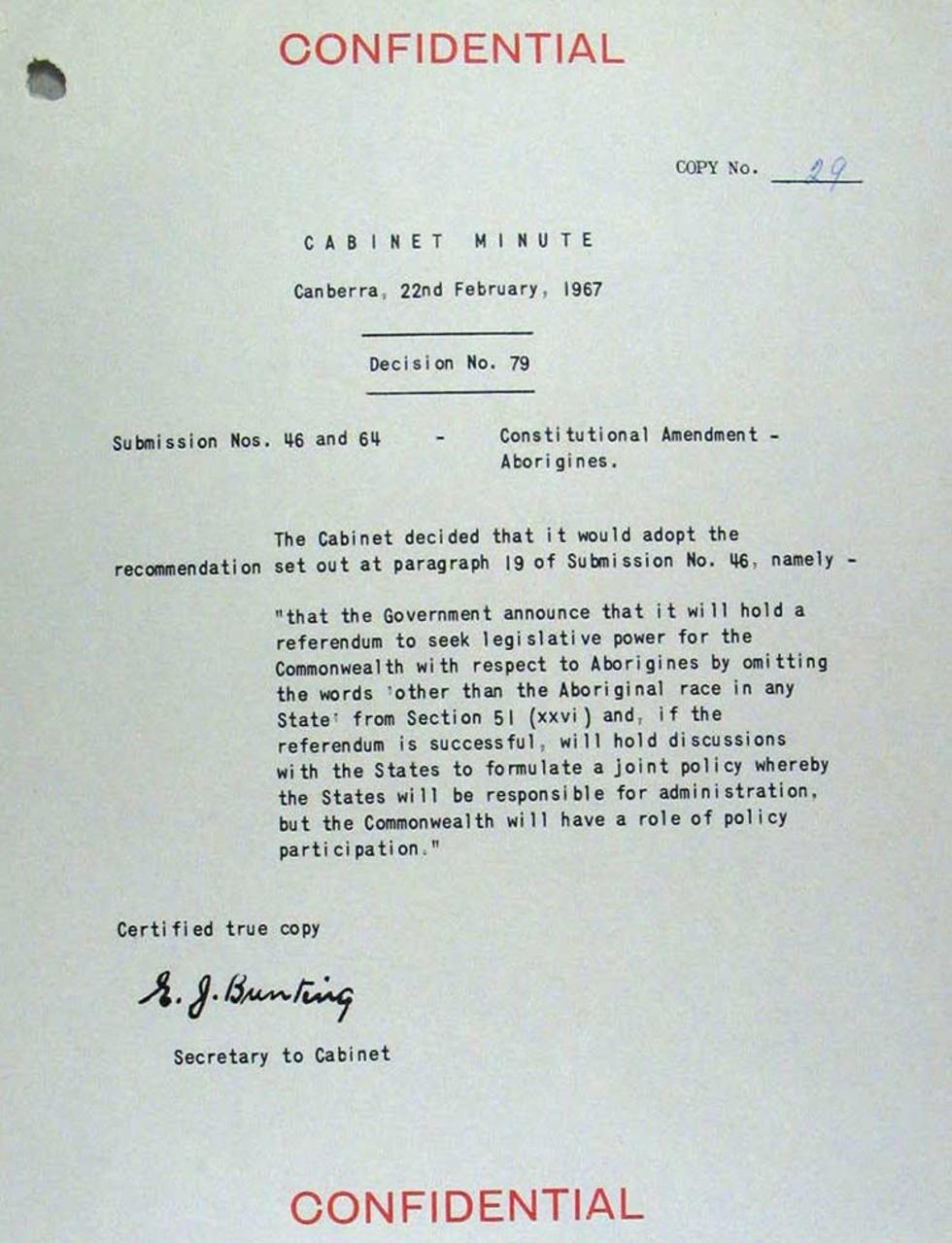
Item ID 1345789. Page number 74, Constitutional amendments 1965 – Referendum
Aboriginal and Torres Strait Islander people should be aware that the National Archives' website and collection contain the names, images and voices of people who have died.
Some records include terms and views that are not appropriate today. They reflect the period in which they were created and are not the views of the National Archives.


Item ID 1345789. Page number 74, Constitutional amendments 1965 – Referendum
[Header and footer in red ink:] CONFIDENTIAL
COPY No. 29
CABINET MINUTE
Canberra, 22nd February, 1967
Decision No. 79
Submission Nos. 46 and 64 – Constitutional Amendment – Aborigines.
The Cabinet decided that it would adopt the recommendation set out at paragraph 19 of Submission No. 46, namely –
"that the Government announce that it will hold a referendum to seek legislative power for the Commonwealth with respect to Aborigines by omitting the words ‘other than the Aboriginal race in any State' from Section 51 (xxvi) and, if the referendum is successful, will hold discussions with the States to formulate a join policy whereby the States will be responsibly for administration, but the Commonwealth will have a role of policy participation."
Certified true copy
[Handwritten signature:] E.J. Bunting
Secretary to Cabinet
This is a Cabinet minute recording the Holt Government's decision to hold the 1967 referendum.
Cabinet is the core decision-making group in the Australian Government. It is made up of the Prime Minister and a selection of government ministers. In 1967, when this minute was produced, cabinet was led by prime minister Harold Holt.
This record shows that the decision to hold a referendum was made on 22 February 1967. This decision was made in response to growing calls for constitutional change lead by First Nations activists and Aboriginal and Torres Strait Islander advocacy groups.
Days after this minute was recorded, the Constitution Alteration (Aboriginals) Act 1967 was passed by the Australian Parliament. This act to change the Constitution was supported by every member of the Australian Parliament.
Parliament alone cannot change the Constitution, however. The proposed changes must be put to the people of Australia in a special vote called a referendum.
For a referendum to be successful, a 'double majority' must be achieved. This means that a majority of voters in every state and a majority of voters across the nation must support the changes.
On 27 May 1967, 90.77% of Australians voted 'Yes' to remove words from the Constitution that discriminated against Aboriginal and Torres Strait Islander people. A majority of voters in all Australian states also supported the changes
The Constitution was changed because of the referendum result. S51(xxvi) was updated so the Australian Parliament could make laws for Aboriginal and Torres Strait Islander people, and s127 was repealed so First Nations people could be counted as part of the Australian population.
Although the Australian Government decided to hold a referendum in 1967 – as this record shows – it was ultimately the Australian people who changed the Constitution.
Why is it important that changes to the Constitution are put to the Australian community? Why do you think those who wrote the Constitution decided that the people – and not the government or Parliament – should have the authority to change it?
Learn how to interpret primary sources, use our collection and more.
